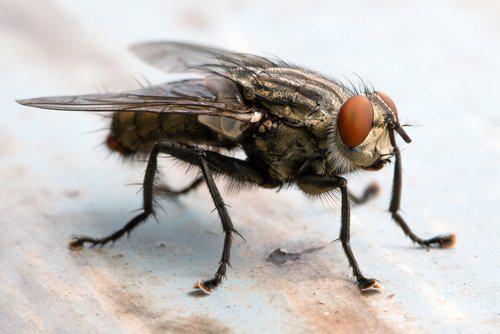Framed by a Fly: Forensic Scientist Says Flies Are Capable of Transporting DNA Evidence
 Inside a courtroom, and to a jury, a DNA sample almost always seals the case against an alleged criminal; it would seem appropriate, considering how the odds of a false identification is lower than one in 10 million. But real and valid cases of DNA contamination - from the “trace” DNA samples that can be transferred by a mere handshake, to a single intact sperm inadvertently finding its way onto a slide containing a woman’s vaginal secretions – suggest that our reliance on DNA evidence has become more than slightly concerning.
Inside a courtroom, and to a jury, a DNA sample almost always seals the case against an alleged criminal; it would seem appropriate, considering how the odds of a false identification is lower than one in 10 million. But real and valid cases of DNA contamination - from the “trace” DNA samples that can be transferred by a mere handshake, to a single intact sperm inadvertently finding its way onto a slide containing a woman’s vaginal secretions – suggest that our reliance on DNA evidence has become more than slightly concerning.
DNA Evidence – Then and Now
When DNA analysis first emerged, a decent amount of evidence was needed to extract just a partial profile (think a blood stain the size of a quarter). But, as modern science has improved, the sample of DNA needed to supply incriminating evidence has decreased exponentially. Today, an entire profile can be created with a sample the size of a pinhead. Unfortunately, that improvement has come at a price; and quite often that price is the wrongful conviction of an innocent person.
Transfer of DNA by Insects
Forensic biologist Annalisa Durdle has spent years studying flies and their ability to transfer DNA evidence onto a crime scene. During that time, she has made some shocking discoveries – many of which challenge information considered common forensic knowledge. For example, human semen, particularly dried semen, happens to be a favorite of flies. If enough is made available, they will eat it until it kills them. Blood, although considered a viable source of food, is less desirable, but it can still easily be transferred to a crime scene through fly fecal matter or vomit.
Analysts often use what they know about flies to rule out whether or not a sample could have been left behind by a person or if the evidence was simply left behind by a passing fly. Unfortunately, even the habits of flies are highly misunderstood. Thought to prefer sun-warmed areas of ceilings, walls, windowsills, and light fixtures, the scientist found fly excrement in poorly lit areas, in lower areas of the room, and often in places that were far from a food source. Of equal concern is that, when analyzing DNA, forensic scientists have no method for determining whether a specimen is semen or fly excrement.
Of course, this is not completely new information; forensic scientists have used the excretions of flies, mosquitoes, and even larvae to place people at the scene of a crime or in the life of a victim. However, this new evidence shows that, even if the victim had no prior history with an alleged criminal, DNA profiling might suggest otherwise. As a result, people could (and probably are) wrongfully convicted of a crime they never committed.
Knowledge Is Power in Your Criminal Case
Effective handling of a criminal case requires more than just knowledge of the law; it requires innovation, creativity, exceptional investigatory skills, constant education, and a willingness to search below the surface. The experienced and skilled Milwaukee criminal defense attorneys at Gimbel, Reilly, Guerin & Brown, LLP possess these traits and are willing to go the extra mile in helping you build a solid criminal defense. Get the representation you deserve. Call 414-271-1440 and schedule your consultation today.
Source:
https://cosmosmagazine.com/the-future/framed-fly







